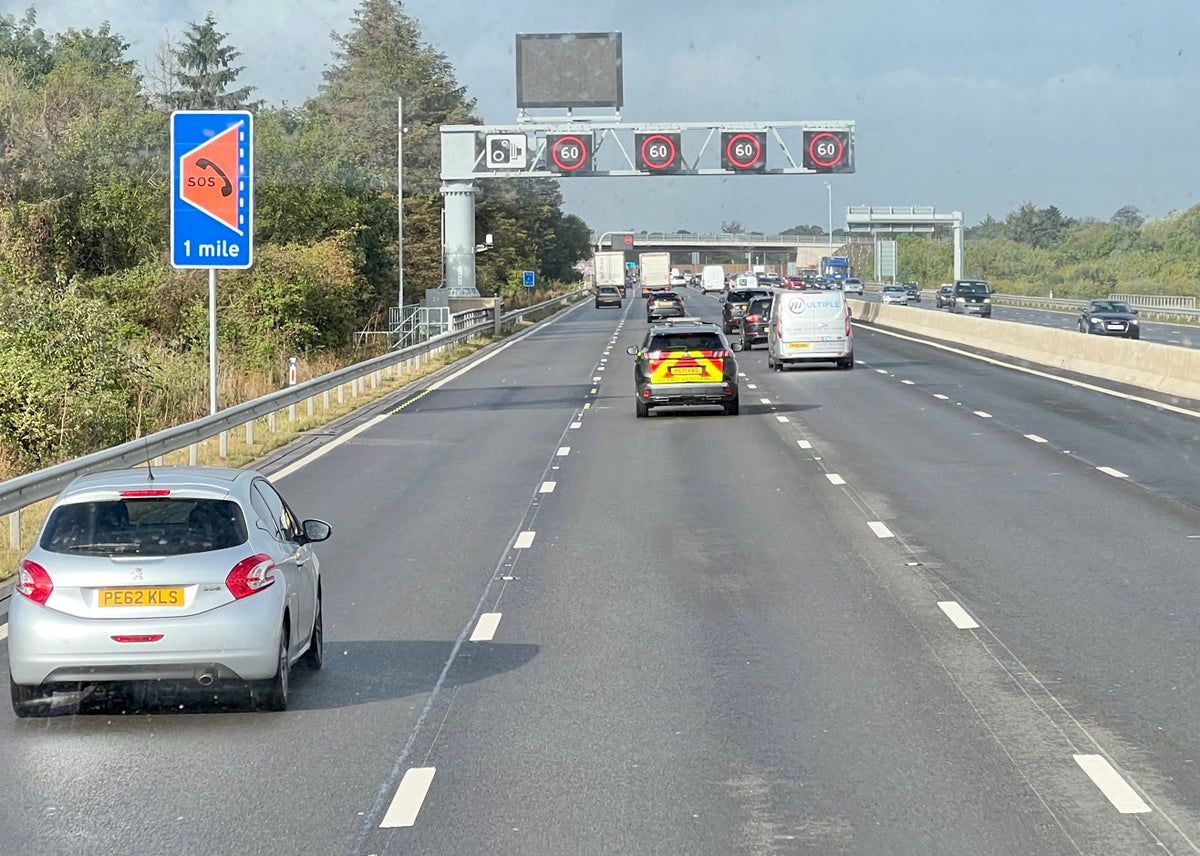
Smart motorways have proved highly controversial since they were introduced in 2006. The aim is to create much-needed capacity to reduce congestion on key areas of the UK’s constrained road network.
But the removal of the normal hard shoulder – the lane on the nearside of most motorways that is normally restricted to emergency use – has been blamed for causing the deaths of motorists who run into difficulties.
The prime minister has promised to scrap smart motorways. But what will that mean for motorists – and road safety?
What is a smart motorway?
A stretch of especially busy motorway where traffic management methods are used to increase capacity and reduce congestion.
There are three types:
- Variable speed limits – motorways where the default is the national speed limit of 70mph but can be reduced with specific lower limits on overhead signs. The aim is to ease congestion and increase safety by moderating speed.
- Dynamic hard shoulder running – at busy times the hard shoulder opens to traffic, adding extra capacity. Overhead signs indicate whether the lane is in use.
- All lane running – the hard shoulder is permanently used as an additional lane, with emergency refuges installed intermittently to allow motorists with mechanical or other issues to gain protection from the traffic. Since the scheme began in 2014, 141 miles of all-lane-running motorways have been created. If there is a breakdown, when “stopped vehicle technology” is in place, it takes National Highways an average of one minute to close the lane.
Which stretches of motorway are smart?
The M25 is entirely smart. Some of the motorways it crosses, including the M23, M3 and M4, are smart for stretches close to London. The M1 is smart for most of its length between London and Leeds.
Parts of the M62, near Leeds, Bradford and Manchester, are smart. The M6 through Cheshire, Staffordshire and the West Midlands is smart, as are spurs near Birmingham on the M42 and M5.
The roll-out of further smart motorways is currently paused to allow for safety data to be studied.

What are the concerns?
Campaigners say that 75 lives have been lost on smart motorways, and several coroners have requested a review of the policy. The Transport Select Committee, which has studied smart motorways in depth, has expressed serious worries about the risks they pose.
Dynamic hard shoulder motorways, meanwhile, “apparently confuse drivers, because the hard shoulder is used unpredictably to tackle congestion,” says the all-party committee of MPs.
“A more consistent approach, where the hard shoulder is used at known times, could clarify the situation for drivers without physically removing the hard shoulder.”
On all lane running, the MPs’ concern is that it deprives motorists in difficulty of an immediate escape from the traffic – with insufficient emergency refuges.
“Deaths on motorways without a permanent hard shoulder have increased from five in 2017 to 15 in 2019,” the committee says.
“Other forms of smart motorways, where the hard shoulder is converted to a live lane at peak times of congestion, have lower casualty rates than removing the hard shoulder altogether.”
Its recent report says: “National Highways should therefore pause the rollout of all-lane running motorways to collect more data, to upgrade and then evaluate the safety of existing all-lane running schemes and to consider alternative options for enhancing capacity on the Strategic Road Network.”
The committee has asked National Highways to retrofit emergency refuge areas to existing all-lane running smart motorways to make them a maximum of one mile apart – “decreasing to every 0.75 miles where physically possible”.
What do the motoring organisations say?
The AA has called for a full review of smart motorways, and recommends the promotion of controlled motorways with a hard shoulder.
The RAC says it “continues to argue for more changes to be made to smart motorways to make them as safe as possible, and to help ensure drivers feel safe when driving on them – especially on stretches of ‘all lane running’ smart motorway where the hard shoulder is removed for good.”
What does the prime minister say?
At one of the hustings for the Conservative party leadership, Liz Truss was asked: “Will you restore hard shoulders to all motorways?”
She responded: “I absolutely think that we need to review them and stop them if they’re not working as soon as possible.
“I do believe the smart motorways experiment hasn’t worked.”
The LBC presenter, Nick Ferrari, said: “Just for clarification, you would stop them?”
“Yes,” replied Ms Truss.
When will they be scrapped?
It is difficult to say. The 13th transport secretary of the 21st century, Anne-Marie Trevelyan, has just taken over at the Department for Transport. No timetable has yet been set for the removal of smart motorways.
What will the effect be?
All other things being equal, congestion is likely to increase. But the prime minister has also repeatedly stated her desire to build more roads – which could ease the pressure on key stretches of the motorway network.
Safety may be diminished, according to the Transport Select Committee: “We are not convinced that reinstating the hard shoulder on all all lane running motorways will improve safety.
“The evidence suggests that doing so could put more drivers and passengers at risk of death and serious injury.”
The MPs point out: “Controlled motorways, which retain the hard shoulder and have technology to regulate traffic, have the lowest casualty rates of all the types of motorway.”







